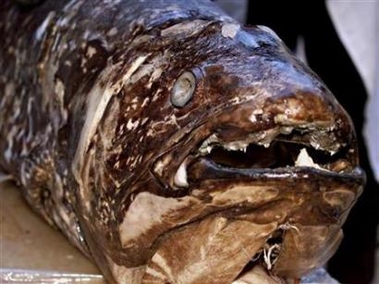|
ZANZIBAR, Tanzania - Fishermen have caught a rare and endangered fish, the coelacanth, off the coast of the Indian Ocean archipelago of Zanzibar, a researcher said on Monday.
The find makes Zanzibar the third place in Tanzania where fishermen have caught the coelacanth, a heavy-bodied, many-finned fish with a three-lobed tail that was thought extinct until it was caught in 1938 off the coast of South Africa. Since then two types of coelacanth have been caught in five other countries: Comoros, Indonesia, Kenya, Madagascar and Mozambique, according to African Coelacanth Ecosystem Program.
|

A coelacanth, an ancient fish once thought to have become extinct when it disappeared from fossil records 80 million years ago,
is shown in Nairobi, Kenya, in this November 21, 2001 file photo. Fishermen in Zanzibar have caught a coelacanth, an official
said on Sunday. (George Mulala/Reuters) | |
"Fishermen informed us that they caught a strange fish in their nets. We rushed to Nungwi (the northern reaches of Zanzibar) to find it's a coelacanth, a rare fish thought to have become extinct when it disappeared from fossil records 80 million years ago," said Nariman Jiddawi of the Institute of Marine Sciences, which is part of the University of Dar es Salaam in Tanzania's commercial capital.
Trade in the coelacanth is banned under the Convention on International Trade in Endangered Species of Wild Fauna and Flora.
"Zanzibar will join a list of sites of having the rare fish caught in its own waters," said Jiddawi, adding the catch weighed 59.5 pounds and measured 4.4 feet.
Four fishermen caught the fish on Saturday, Jiddawi said.
Mussa Aboud Jume, director of fisheries in Zanzibar, said that the coelacanth will be preserved and put on display at the Zanzibar Museum.
A statement of the Institute of Marine Sciences said that 35 coelacanths have been caught since September 2003 in Mtwara, a southern region of Tanzania, and mostly along the coast of Tanga in Tanzania's north.
Coelacanths are the only living animals to have a fully functional intercranial joint, a division separating the ear and brain from the nasal organs and eye, according to an Institute of Marine Sciences statement.
Copyright © 2007 The Associated Press. All rights reserved.
Post Your Comments Here...
Note
Coelacanths are known from the fossil record dating back over 360 million years, with a peak in abundance about 240 million years ago. Pre-dating the dinosaurs by millions of years and once thought to have gone extinct with them, it was discovered alive and well in 1938.
More information and resources on Coelacanths:
|